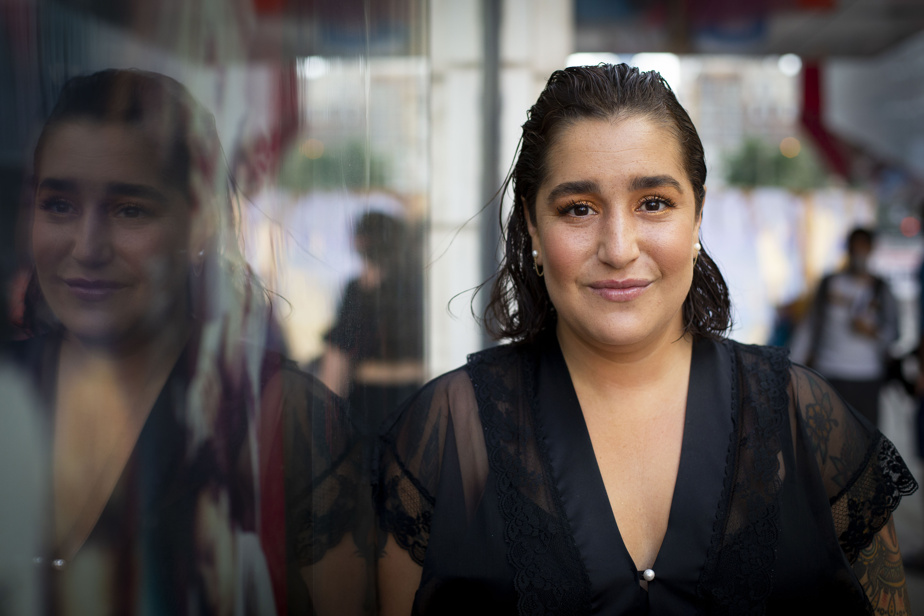Mariana Mazza loves fashion. On television sets, she shows off colorful, exuberant and always different outfits. In the documentary The price of fashionbroadcast Wednesday on Télé-Québec, the comedian becomes aware of the impact of her clothing consumption and tries to give a real second life to pieces she has in excess.
“I don’t think there are enough opportunities in a lifetime to wear all the clothes I have. This is the greatest sadness of my life. » This statement from Mariana Mazza comes in the first minutes of the documentary, as she unabashedly reveals the extent of her clothing possessions, stored in different rooms of her new home. Here, dozens of pairs of shoes, classified by brand, color and style. There, long-sleeved sweaters and summer shorts that she forgot existed. Not to mention the extravagant outfits she hasn’t worn on TV yet.
“Sometimes I say to myself, ‘I have nothing to wear.’ That’s the worst part, she said in an interview by videoconference, wearing a rather classic striped dress. Like someone who has 10 cars and doesn’t know which one to choose! That’s where it gets awkward, where I go, “Oh! I’m not a good citizen.” »
A fashion lover since she was young – “I don’t buy out of desire, but out of passion,” she explains – Mariana Mazza has seen this flame grow, as has an interest in fashion houses. couture, with the aura of his profession and his purchasing power. From now on, the one who grew up in Montreal North has the means to enter Louis Vuitton and come out with a suitcase, as she proudly told Patricia Paquin on the show The other lunchtime at the next table.

PHOTO PIERRE MANNING, PROVIDED BY TÉLÉ-QUÉBEC
Mariana Mazza’s relationship with clothes is at the heart of the documentary The price of fashion.
I have always loved clothes. I like dressing, I like textures, colors. In my entourage, I am quite the one who consumes the most and I do it even more since I have the means to do so.
Mariana Mazza
She therefore saw herself as the perfect candidate for this project that the production company Trinome & Filles wanted to see carried by a questioning over-consumer of fashion.
“It was an issue for a very long time in my life and it still is,” she emphasizes. If I don’t close all my apps and talk to myself, I’m going to be shopping every day. » However, she does not talk about addiction. “It’s not a need, it’s that I like it. It’s not the same thing. I can live without buying clothes, but I’m not going to do it because there’s no impact… Until I make a documentary. »
Tons of clothes in the dump
With this film, directed by Félix Trépanier, she pushed her questions further by meeting various fashion and marketing experts to understand how she and we, collectively, managed to consume so much. The documentary also addresses ways to dress more responsibly and, what was the biggest revelation for her: the end of life of our clothes.
The observation is shocking. Only 6% of clothing that passes through a donation center is put on the shelves, indicates Claude Maheux-Picard, general director of the Center for Technology Transfer in Industrial Ecology. Where does the rest go? To landfill.
In donation centers, stained, holed and stretched pieces are generally discarded for sorting. Combined with surplus clothing in good condition, they are sent to textile recyclers whose job is not to recycle the material, but to sort it to often send it to Africa.
Faced with the piles and bundles of clothes accumulating in the warehouse of a recycler she visits, Mariana is shaken. He explains to him that several items, which cannot be exported to Africa and Asia, its main export markets, will end up in landfill. This is the case not only for poor quality clothing, but also for winter coats and boots that have no use there.
Nonsense, according to her, when here, new arrivals have no money to clothe themselves as winter approaches. “After this documentary, I would like there to be an organization that would say: “If you bring us your clothes, we have the labor, we will give them back.” There are too many on the resale market. We must give quality clothing to people who cannot afford to buy it. I also hope that people will sort things properly, that they will repair their clothes before giving them away and I hope that they will stop going to fast fashion stores. I think that if everyone makes an effort, we are capable of having something beautiful. »
Since filming ended, her clothing consumption has decreased “a lot”. “I relapse occasionally, sure, but I definitely buy less than before. » Even if flamboyant outfits continue to define her, she tries to make more classic choices, to take more care of her clothes and when the time comes to donate them, she does so directly to people who need them. Who wants a sequin one-piece?
September 20, at 8 p.m., on Télé-Québec and on telequebec.tv
